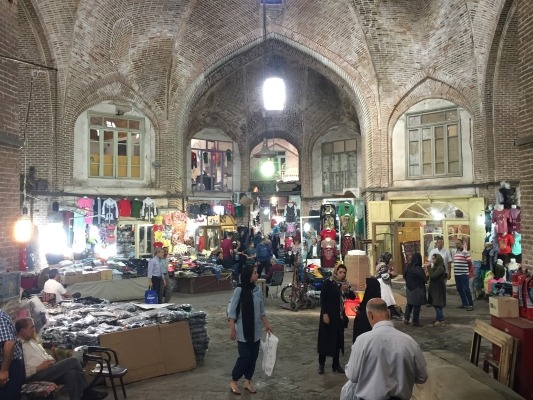Tabriz
Tabriz, the capital of East Azerbaijan province, is one of the ancient historical cities of Iran destinations located in the northwest of the country and one of the major trade centers on the Silk Road. It is one the most attractive city of Iran cultural tours for travelers from all around the world, so it was an exemplary tourist city of 2018 by the Organization of Islamic Cooperation. Tabriz is the home to one of the richest cultures called Azeri; where they speak in the Azeri language and still fulfill Azeri traditions and culture. It is the fifth-largest city in Iran after Tehran, Mashhad, Isfahan, and Shiraz and is the fourth most populous after Tehran, Mashhad, and Isfahan. Tabriz is situated near to Ararat mountains and in an earthquake zone, so it was razed to the ground at least 2

times; as in 1721 and another time in 1780 and several times was destroyed by invading armies. However, Tabriz turned to a modern and industrialized city over the time. It was the hub for trade and business and now it is the main hub for food and leather industry. Marco Polo the Venetian explorer told about Tabriz: “The city has such a good position that merchandise is brought thither from India, Baudas (Baghdad) and Gemesor (Persia) … it is a city where merchants make a large profit”. Tabriz is also famous for hand knotted carpets so it was called World Carpet weaving city by the World Craft Council in October 2015.
History of Tabriz
Despite being modern and industrialized, Tabriz is an ancient city with a historical and civilized background. There is no document of early history of Tabriz but the evidence of the earliest civilization belongs to an iron grave yard dating back to 1st millennium B.C which was excavated in the north side of Blue Mosque in 1990s. Another evidence is an inscription of the Assyrian King Sargon II dating to 714 B.C. which Tabriz was mentioned as Tarui or Tauris.
Tabriz was selected as the capital for several times in the history and for the first time it was the Capital from Atropates time, the Persian nobleman who served Darius III; according to the documented history.
Topography of Tabriz
Tabriz lies on a valley between Eynali and Sahand Mountains in the shore of Aji River and Ghuri River. Its elevation ranges between 1350-1600 m above sea level.
Climate of Tabriz
Climate of Tabriz generally is a semi-arid and cold for the most months and snow during the winter months and rain in autumn which causes a humid climate but it is mild and pleasant weather during spring with rain and semi-hot during the summer while cool winds blow from east to west.
Attractions of Tabriz
There are some fascinated historical monuments which make Tabriz as a top destination for Iran cultural tours and many natural attractions for Iran adventure trips. Blue Mosque, Bazaar of Tabriz, Constitutional Museum.
Bazaar of Tabriz is the largest historical covered market featuring traditional eastern architectural designs in the Middle East and one of the most important commercial centers on the Silk Road. It consists of several small bazaars with different functions such as Mozaffarieh for hand-knotted carpets, Amir Bazaar for gold and jewelry, a shoe bazaar, a crafts bazaar, and many other various goods. The bazaar of Tabriz was inscribed as UNESCO World Heritage Sites in 2010.
Blue Mosque is one of Iran’s historical masterpieces located in Tabriz was built in 1465 by order of Jahan Shah who was the ruler of Kara Koyunlu. It was one of the fantastic architectural buildings of its time before damaging in the earthquake of 1773. The surface of the mosque was covered by intricate turquoise mosaics and blue majolica tiles and calligraphy which it took about 25 years to be finished. The interior of the mosque is also decorated with blue majolica tiles. The facades were designed by the diverse Kufic and Thuluth scripts, the arabesque patterns which all were artistic work created by the famous calligrapher Nematollah-ben-Mohammad-ol-Bavab. It was reconstructed by Reza Memaran Benam under supervision of Iranian Ministry of Culture in 1973.
El Goli is a historical garden located in Tabriz. It was constructed in the 18th century but according to some sources, it is supposed to be built earlier around the 14th century. It contains a large artificial lake with 210 meters square. The garden was named “Shah Goli” which means “Royal Pond” but after revolution it was renamed El Goli means garden for people. A pavilion was built on the north side of the lake.
Kandovan is an ancient village situated in the foothills of Mount Sahand and in the Sahand protected area in northwest of Iran. It is one of the wonderful and amazing Iran destinations with manmade rock dwellings as excavated caves in the cliffs. It is more interesting to know that it has still many inhabitants. The shape of each house is a cone form. Kandovan rocks are formed in the consequences of the eruption of Sahand volcano and the natural movement of lahar flow which consists of porous, round and angular pumice together with other volcanic particles.
